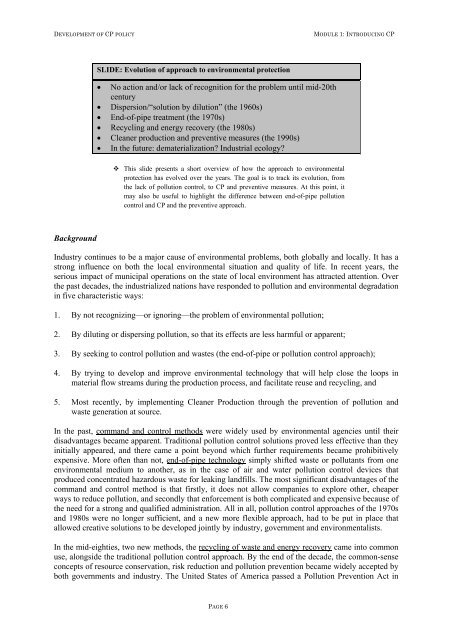Manual on the Development of Cleaner Production Policies ... - Unido
Manual on the Development of Cleaner Production Policies ... - Unido
Manual on the Development of Cleaner Production Policies ... - Unido
Create successful ePaper yourself
Turn your PDF publications into a flip-book with our unique Google optimized e-Paper software.
DEVELOPMENT OF CP POLICY<br />
MODULE 1: INTRODUCING CP<br />
SLIDE: Evoluti<strong>on</strong> <strong>of</strong> approach to envir<strong>on</strong>mental protecti<strong>on</strong><br />
• No acti<strong>on</strong> and/or lack <strong>of</strong> recogniti<strong>on</strong> for <strong>the</strong> problem until mid-20th<br />
century<br />
• Dispersi<strong>on</strong>/“soluti<strong>on</strong> by diluti<strong>on</strong>” (<strong>the</strong> 1960s)<br />
• End-<strong>of</strong>-pipe treatment (<strong>the</strong> 1970s)<br />
• Recycling and energy recovery (<strong>the</strong> 1980s)<br />
• <strong>Cleaner</strong> producti<strong>on</strong> and preventive measures (<strong>the</strong> 1990s)<br />
• In <strong>the</strong> future: dematerializati<strong>on</strong>? Industrial ecology?<br />
This slide presents a short overview <strong>of</strong> how <strong>the</strong> approach to envir<strong>on</strong>mental<br />
protecti<strong>on</strong> has evolved over <strong>the</strong> years. The goal is to track its evoluti<strong>on</strong>, from<br />
<strong>the</strong> lack <strong>of</strong> polluti<strong>on</strong> c<strong>on</strong>trol, to CP and preventive measures. At this point, it<br />
may also be useful to highlight <strong>the</strong> difference between end-<strong>of</strong>-pipe polluti<strong>on</strong><br />
c<strong>on</strong>trol and CP and <strong>the</strong> preventive approach.<br />
Background<br />
Industry c<strong>on</strong>tinues to be a major cause <strong>of</strong> envir<strong>on</strong>mental problems, both globally and locally. It has a<br />
str<strong>on</strong>g influence <strong>on</strong> both <strong>the</strong> local envir<strong>on</strong>mental situati<strong>on</strong> and quality <strong>of</strong> life. In recent years, <strong>the</strong><br />
serious impact <strong>of</strong> municipal operati<strong>on</strong>s <strong>on</strong> <strong>the</strong> state <strong>of</strong> local envir<strong>on</strong>ment has attracted attenti<strong>on</strong>. Over<br />
<strong>the</strong> past decades, <strong>the</strong> industrialized nati<strong>on</strong>s have resp<strong>on</strong>ded to polluti<strong>on</strong> and envir<strong>on</strong>mental degradati<strong>on</strong><br />
in five characteristic ways:<br />
1. By not recognizing—or ignoring—<strong>the</strong> problem <strong>of</strong> envir<strong>on</strong>mental polluti<strong>on</strong>;<br />
2. By diluting or dispersing polluti<strong>on</strong>, so that its effects are less harmful or apparent;<br />
3. By seeking to c<strong>on</strong>trol polluti<strong>on</strong> and wastes (<strong>the</strong> end-<strong>of</strong>-pipe or polluti<strong>on</strong> c<strong>on</strong>trol approach);<br />
4. By trying to develop and improve envir<strong>on</strong>mental technology that will help close <strong>the</strong> loops in<br />
material flow streams during <strong>the</strong> producti<strong>on</strong> process, and facilitate reuse and recycling, and<br />
5. Most recently, by implementing <strong>Cleaner</strong> Producti<strong>on</strong> through <strong>the</strong> preventi<strong>on</strong> <strong>of</strong> polluti<strong>on</strong> and<br />
waste generati<strong>on</strong> at source.<br />
In <strong>the</strong> past, command and c<strong>on</strong>trol methods were widely used by envir<strong>on</strong>mental agencies until <strong>the</strong>ir<br />
disadvantages became apparent. Traditi<strong>on</strong>al polluti<strong>on</strong> c<strong>on</strong>trol soluti<strong>on</strong>s proved less effective than <strong>the</strong>y<br />
initially appeared, and <strong>the</strong>re came a point bey<strong>on</strong>d which fur<strong>the</strong>r requirements became prohibitively<br />
expensive. More <strong>of</strong>ten than not, end-<strong>of</strong>-pipe technology simply shifted waste or pollutants from <strong>on</strong>e<br />
envir<strong>on</strong>mental medium to ano<strong>the</strong>r, as in <strong>the</strong> case <strong>of</strong> air and water polluti<strong>on</strong> c<strong>on</strong>trol devices that<br />
produced c<strong>on</strong>centrated hazardous waste for leaking landfills. The most significant disadvantages <strong>of</strong> <strong>the</strong><br />
command and c<strong>on</strong>trol method is that firstly, it does not allow companies to explore o<strong>the</strong>r, cheaper<br />
ways to reduce polluti<strong>on</strong>, and sec<strong>on</strong>dly that enforcement is both complicated and expensive because <strong>of</strong><br />
<strong>the</strong> need for a str<strong>on</strong>g and qualified administrati<strong>on</strong>. All in all, polluti<strong>on</strong> c<strong>on</strong>trol approaches <strong>of</strong> <strong>the</strong> 1970s<br />
and 1980s were no l<strong>on</strong>ger sufficient, and a new more flexible approach, had to be put in place that<br />
allowed creative soluti<strong>on</strong>s to be developed jointly by industry, government and envir<strong>on</strong>mentalists.<br />
In <strong>the</strong> mid-eighties, two new methods, <strong>the</strong> recycling <strong>of</strong> waste and energy recovery came into comm<strong>on</strong><br />
use, al<strong>on</strong>gside <strong>the</strong> traditi<strong>on</strong>al polluti<strong>on</strong> c<strong>on</strong>trol approach. By <strong>the</strong> end <strong>of</strong> <strong>the</strong> decade, <strong>the</strong> comm<strong>on</strong>-sense<br />
c<strong>on</strong>cepts <strong>of</strong> resource c<strong>on</strong>servati<strong>on</strong>, risk reducti<strong>on</strong> and polluti<strong>on</strong> preventi<strong>on</strong> became widely accepted by<br />
both governments and industry. The United States <strong>of</strong> America passed a Polluti<strong>on</strong> Preventi<strong>on</strong> Act in<br />
PAGE 6
















